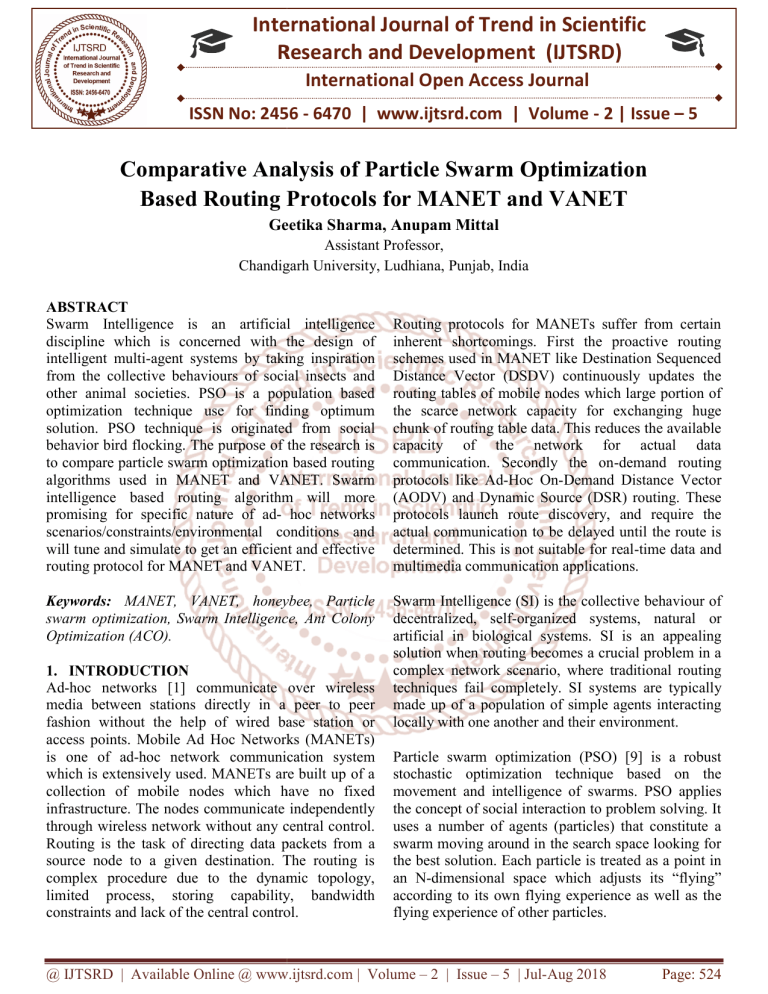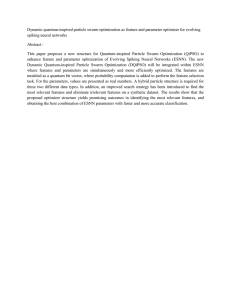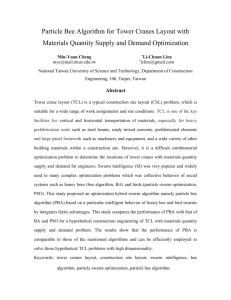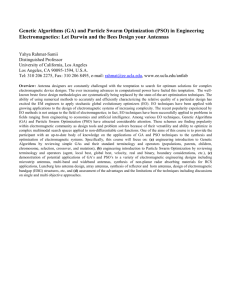
International Journal of Trend in Scientific
Research and Development (IJTSRD)
International Open Access Journal
ISSN No: 2456 - 6470 | www.ijtsrd.com | Volume - 2 | Issue – 5
Comparative Analysis off Particle Swarm Optimization
Based Routing Protocols for MANET and
nd VANET
Geetika Sharma
Sharma, Anupam Mittal
Assistant Professor,
Chandigarh University, Ludhiana, Punjab, India
ABSTRACT
Swarm Intelligence is an artificial intelligence
discipline which is concerned with the design of
intelligent multi-agent
agent systems by taking inspiration
from the collective behaviours of social insects and
other animal societies. PSO is a population based
optimization technique use for finding optimum
solution. PSO technique is originated
nated from social
behavior bird flocking. The purpose of the research is
to compare particle swarm optimization based routing
algorithms used in MANET and VANET. Swarm
intelligence based routing algorithm will more
promising for specific nature of ad- hoc networks
scenarios/constraints/environmental conditions and
will tune and simulate to get an efficient and effective
routing protocol for MANET and VANET.
Keywords: MANET, VANET, honeybee, Particle
swarm optimization, Swarm Intelligence, Ant Colony
Optimization (ACO).
1. INTRODUCTION
Ad-hoc
hoc networks [1] communicate over wireless
media between stations directly in a peer to peer
fashion without the help of wired base station or
access points. Mobile Ad Hoc Networks (MANETs)
is one of ad-hoc network communication system
which is extensively used. MANETs are built up of a
collection of mobile nodes which have no fixed
infrastructure. The nodes communicate independently
through wireless network without any central control.
Routing is the task of directing
ng data packets from a
source node to a given destination. The routing is
complex procedure due to the dynamic topology,
limited process, storing capability, bandwidth
constraints and lack of the central control.
Routing protocols for MANETs suffer from certain
inherent shortcomings. First the proactive routing
schemes used in MANET like Destination Sequenced
Distance Vector (DSDV) continuously updates the
routing tables of mobile nodes which large portion of
the scarce network capacity for exchanging huge
chunk of routing table data. This reduces the available
capacity of the network for actual data
communication. Secondly the on-demand
on
routing
protocols like Ad-Hoc On-Demand
Demand Distance Vector
(AODV) and Dynamic Source
rce (DSR) routing. These
protocols launch route discovery, and require the
actual communication to be delayed until the route is
determined. This is not suitable for real-time
real
data and
multimedia communication applications.
Swarm Intelligence (SI) is the collective behaviour of
decentralized, self-organized
organized systems, natural or
artificial in biological systems. SI is an appealing
solution when routing becomes a crucial problem in a
complex network scenario, where traditional routing
techniques fail completely.
ly. SI systems are typically
made up of a population of simple agents interacting
locally with one another and their environment.
Particle swarm optimization (PSO) [9] is a robust
stochastic optimization technique based on the
movement and intelligence of swarms. PSO applies
the concept of social interaction to problem solving. It
uses a number of agents (particles) that constitute a
swarm moving around in the search space looking for
the best solution. Each particle is treated as a point in
an N-dimensional
al space which adjusts its “flying”
according to its own flying experience as well as the
flying experience of other particles.
@ IJTSRD | Available Online @ www.ijtsrd.com | Volume – 2 | Issue – 5 | Jul-Aug
Aug 2018
Page: 524
International Journal of Trend in Scientific Research and Development (IJTSRD) ISSN: 2456-6470
Routing algorithms which are based on swarm
intelligence are: Collective system capable of accomplishing
difficult tasks in dynamic and varied environments
without any external guidance or control and with
no central coordination.
Achieving a collective performance which could
not normally be achieved by an individual acting
alone.
Constituting a natural model particularly suited to
distribute problem solving.
2. SWARM INTELLIGENCE
Swarm Intelligence (SI) is mainly defined as the
behaviour of natural or artificial self-organized,
decentralized systems. Swarms interact locally with
each other or with external agents i.e. environment
and can be in the form of bird flocks, ants, bees etc. It
is the property of a system whereby the collective
behaviour of (unsophisticated) agents interacting
locally with their environment cause coherent
functional global patterns to emerge. SI provides a
basis with which it is possible to explore collective (or
distributed) problem solving without centralized
control or the provision of a global model.
SI based approaches are nature and bio-inspired.
Swarms are abundantly found in nature. In the nature
animals form into swarms to search food, build nests,
to hunt and avoid being hunted etc. Each individual
swarm has simple rule of access to a limited amount
of information via its immediate neighbours or local
environment. It consists of mainly PSO, Ant colony
optimization (ACO) and honeybee paradigms. The
population of the potential solution is called as swarm
and each individual in the swarm is defined as
particle. The particles fly in the swarm to search their
best solution based on experience of their own and the
other particles of the same swarm.
The SI based approaches are more promising from
other conventional techniques for optimization
problems, due to the nature, architecture, topology
and functionality of ad hoc networks. SI approaches
are more suitable for the routing and energy resources
optimization related issues in MANETs.
Bio inspired, SI approaches are more promising for
Ad-hoc networks due to the following prominent
aspects 1.locality of interactions 2.availability of
multiple paths 3. Self organising 4. Failure backup 5.
ability to adapt in a quick and robust way to
topological and traffic changes and component
failures.
3. Particle Swarm Optimization
Particle swarm optimization (PSO) is a populationbased stochastic optimization technique developed by
Kennedy and Eberhart in 1995. The use of PSO
algorithm is to determine optimum solution. In PSO
algorithm, an optimal solution is found from the
social behavior of bird flocking. With the aim of
discovering patterns that govern the ability of birds to
fly synchronously and to suddenly change direction
with a regrouping in an optimal formation. PSO
consist of group of individual called as ―particles‖. The
particles fly through multidimensional search space
looking for best solution. The effective solution can
be obtained by using common information of the
group and information own by particles itself. For
better performance, each particle adjusts its velocity
time to time based on its current velocity with respect
to its previous best position and also the position of
current best particle in the population. For solving the
optimization problems and combinatorial problems
PSO algorithm is most useful [10].
A PSO algorithm maintains a swarm of particle
represents the potential solution. In simple terms,
particles
are
randomly
fly
through
the
multidimensional search space, the particle adjust its
position according to its own experienced and that of
its neighbors. Let xi(t) represent the position of
particle i in the search space at a discrete time step t .
When the particle moves it get some velocity and its
original position is changed, i.e. It is the velocity
vector that drives the optimization process and
reflects both the related knowledge of the particle and
socially exchanged information from the particle's
neighborhood. The experimental knowledge of
particle is directly proportional to the distance of
particle from its own best position known as particle
best (pbest). There are basically two concept of PSO
algorithm, namely pbest and gbest. In global best
(gbest) the neighborhood for each particle is entire
swarm. The network establish in gbest PSO is by
using star topology, in which the social particle
velocity is updated regularly which gives information
obtained from all the particle in swarm.
In personal best (pbest) PSO the network form by
using ring social network topology where smaller
@ IJTSRD | Available Online @ www.ijtsrd.com | Volume – 2 | Issue – 5 | Jul-Aug 2018
Page: 525
International Journal of Trend in Scientific Research and Development (IJTSRD) ISSN: 2456-6470
neighborhood are define for each particle. In this
network, information exchanged between the
neighborhoods of particle, which provide local
knowledge of the environment.
4. SWARM
INTELLIGENCE
BASED
ROUTING ALGORITHM
Routing protocols are proposed for mobile ad-hoc
networks have revealed that the on-demand routing
protocols perform better in terms of packet delivery
and routing overhead than proactive routing schemes
especially in the presence of node mobility. Proactive
and hybrid schemes do not perform well in dynamic
topologies because of the following two major
factors:
1.Slow detection of broken links and 2. Periodic
exchange of route updates even when routes are not
needed. [2]
The routing protocols under idealistic settings where
all nodes function properly. The behaviour of routing
protocols where some nodes may be faulty [3]. The
paper has proposed that AODV outperforms OLSR in
terms of packet delivery ratio while OLSR achieves a
much lower end to end delay.
A new cooperative coevolving particle swarm
optimization (CCPSO) [4] algorithm addresses the
issue of scaling up particle swarm optimization (PSO)
algorithms in solving large-scale optimization
problems (up to 2000 real-valued variables). The
proposed CCPSO2 builds on the success of an early
CCPSO that employs an effective variable grouping
technique random grouping. CCPSO2 adopts a new
PSO position update rule that relies on Cauchy and
Gaussian distributions to sample new points in the
search space, and a scheme to dynamically determine
the coevolving subcomponent sizes of the variables.
Results and analysis suggest that CCPSO2 is a highly
competitive optimization algorithm for solving largescale and complex multimodal optimization problems.
The designing of optical networks [5] are focused on
the wavelength division multiplexing (WDM)
technology. This technology divides the huge
bandwidth of an optical fiber into different
wavelengths, providing different available channels
per link of fiber. However, when it is necessary to
establish a set of demands, a problem comes up. This
problem is known as a routing and wavelength
assignment (RWA) problem. Depending on the traffic
pattern, two varieties of a RWA problem have been
considered in the literature: static and dynamic.
Swarm intelligence is very suitable to solve the RWA
problem, and presumably that it may obtain such
quality results not only in diverse telecommunication
optimization problems, but also in other engineering
optimization problems.
A new proposal of using particle swarm optimization
algorithms to solve multi-objective optimization
problems is presented. The algorithm is constructed
based on the concept of Pareto dominance, as well as
a state-of-the-art ‘parallel’ computing technique that
intends to improve algorithmic effectiveness and
efficiency simultaneously. The proposed parallel
particle swarm multi-objective evolutionary algorithm
(PPS-MOEA) [9] is tested through a variety of
standard test functions its performance is compared
with six noted multi-objective algorithms. The
computational experience gained from the first two
experiments indicates that the algorithm proposed in
this article is extremely competitive when compared
with other MOEAs, being able to accurately, reliably
and robustly.
Inspired by swarm intelligence observed in social
species, the artificial self-organized networking
(SON) [10] systems are expected to exhibit some
intelligent features (e.g., flexibility, robustness,
decentralized control, and self-evolution, etc.) It is
concluded that the bio-inspired mechanism is indeed a
powerful source of innovative networking paradigm
for artificial SON systems.
Swarm intelligence [7] a new approach for an on
demand ad-hoc routing algorithm is proposed. The
key components of feedback mean that an individual
recruits other individuals by some directive, such as
dancing of bees in order to lead some other bees onto
a specific food source site. Feedback, fluctuations and
multiple interactions [17]. Positive Negative feedback
avoids all individuals accumulating on the same task
by rebalancing the attraction negatively, such as
abandoning the exhausted food source.3
5. CONCLUSION
MANET consists of a set of mobile nodes and
challenges in routing due to dynamic network
topology, power conservation in wireless nodes. The
characteristics of MANET such as bandwidth
constrained, energy constrained, limited physical
security and dynamic network topology etc.
@ IJTSRD | Available Online @ www.ijtsrd.com | Volume – 2 | Issue – 5 | Jul-Aug 2018
Page: 526
International Journal of Trend in Scientific Research and Development (IJTSRD) ISSN: 2456-6470
Randomized change of domain causes change in
topology of networks. Hence the major issue related
to MANETs is routing. The proactive and reactive
routing algorithms have their own limitations and are
not found suitable for routing in MANET mainly
when real time applications. The aim of the study is to
investigate the advantages of the different approaches
in relation to the characteristics of urban
environments and to concrete application models for
real-world MANETS.
6. REFERENCES
1. Siva. R. M, C. and B. S. Manoj, “Ad-Hoc
Wireless Networks: Architecture and Protocols",
Pearson, USA, 2004.
2. E. Royer and C. K. Toh, “A review of current
routing protocols for ad-hoc mobile wireless
networks”, IEEE Personal Communications, 1999.
3. Rajagopalan. R, Dahlstrom, “Performance
comparison of routing protocols in mobile ad hoc
networks in the presence of faulty nodes”, {IEEE
International Conference On Wireless Information
Technology And Systems (ICWITS)}, 11-16
NOV. 2012.
4. Xiaodong Li, Xin Yao, “Cooperatively
Coevolving Particle Swarms for Large Scale
Optimization”,
{IEEE
Transactions
On
Evolutionary Computation}, VOL. 16, NO. 2,
APRIL 2012.
5. Rubio largo A, Vega Rodriguez M, Gomez
Pulido, Sanchez-Perez, “Comparative Study on
Multi objective Swarm Intelligence for the
Routing and Wavelength Assignment problem”,{
IEEE Transactions On Systems, Man And
Cybernetics Part C}, Volume:42 , Issue: 6 , Nov
2012.
6. Asadinia. S, Rafsanjani. M. k, Saeid. A. B, “A
novel routing algorithm based-on ant colony in
Mobile Ad hoc Networks”, { 3rd IEEE
International
Conference
on Ubi-media
Computing (U-Media)}, 5-6 July 2010.
7. G. Di Caro, F. Ducatelle, L. M. Gambardella,
“Swarm Intelligence for routing in mobile ad hoc
networks”, { In Proceedings of the 2005 IEEE
Swarm Intelligence Symposium, SIS 2005}, pp.
76–83, 2005.
8. B. Chandra Mohan & R. Baskaran, “Survey on
Recent Research and Implementation of Ant
Colony Optimization in Various Engineering
Applications”,
{International
Journal
of
Computational Intelligence Systems Taylor and
Franchis}, Volume 4, Issue 4, 2011.
9. Shu-Kai S. Fana & Ju-Ming Changa, “A parallel
particle swarm
optimization algorithm
for
multi-objective
optimization
problems”,
{Engineering Optimization Taylor and Franchis},
Volume 41, Issue 7, 2009.
10. Zhang, Z. ; Long, K. ; Wang, J. ; Dressler, F ,“On
Swarm Intelligence Inspired Self-Organized
Networking: Its Bionic Mechanisms, Designing
Principles and Optimization Approaches”,
Communications Surveys & Tutorials, IEEE, (
Issue: 99 ), 04 July 2013.
11. Bahriye Akay, Dervis Karaboga, “A modified
Artificial Bee Colony algorithm for real-parameter
optimization”,{ Elsevier}, 2010.
12. F. Ducatelle, G. D. Caro, and L. M. Gambardella,
“Using ant agents to combine reactive and
proactive strategies for routing in mobile ad hoc
networks”,
{International
Journal
of
Computational Intelligence and Applications},
vol. 5, no. 2, pp. 169–184, 2005.
13. F. Dressler and O. Akan, “Bio-inspired
networking: from theory to practice”,{IEEE
Communication Magazine.}, vol. 48, no. 11, pp.
176–183, 2010
14. F. Dressler and O. Akan, “A Survey on Bioinspired Networking”, {Elsevier Computer
Networks}, vol. 54, no. 6, pp. 881–900, 2010.
15. O. Tonguz, “Biologically inspired solutions
to fundamental transportation problems”, {IEEE
Communication. Magazine}, vol. 49, no. 11, pp.
106– 115, Nov. 2011.
16. Frederick Ducatelle, Gianni A. Di Caro, Luca M.
Gambardella," An Evaluation of Two Swarm
Intelligence MANET Routing Algorithms in an
Urban Environment”, {IEEE Swarm Intelligence
Symposium}, 2010.
@ IJTSRD | Available Online @ www.ijtsrd.com | Volume – 2 | Issue – 5 | Jul-Aug 2018
Page: 527
International Journal of Trend in Scientific Research and Development (IJTSRD) ISSN: 2456-6470
17. Roth, M., “Termite: A Swarm Intelligent Routing
Algorithm for Mobile Wireless Ad-Hoc
Networks”, {Thesis and Dissertations}, Cornell
University Graduate School (2005).
20. Falko
Dresser,
“A
Study
of
Self
Organization Mechanism in Ad-hoc and Sensor
Networks“,
{Elsevier
Computer
Communications}, Vol. 31(13), 2008.
18. Ajith Abraham, Crina Grosan, Vitorino
Ramos, “Stigmergic Computational Intelligence”,
{Spinger}, 2010.
21. S. Lalwani, S. Singhal, R. Kumar and N. Gupta,
“A Comprehensive Survey: Applications of MultiObjective Particle Swarm Optimization (Mopso)
Algorithm”, {Transactions on Combinatorics},
Vol. 2 No. 1 (2013), pp. 39-101.
19. Muhammad Saleem a, Gianni A. Di Caro b,
Muddassar Farooq, “Swarm
intelligence
based routing protocol for wireless sensor
networks: Survey and future directions”,
{Information Sciences Elsevier}, 2010.
@ IJTSRD | Available Online @ www.ijtsrd.com | Volume – 2 | Issue – 5 | Jul-Aug 2018
Page: 528







